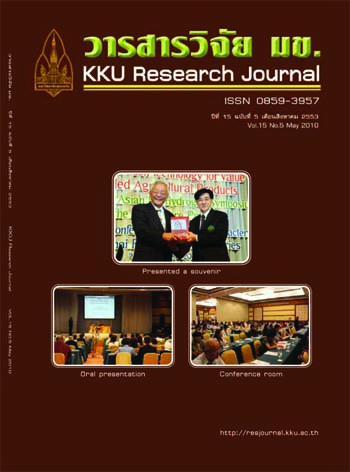Quantitative method for assessing biogenic amines in fermented food products by colorimetry
Main Article Content
Abstract
In this study, a method of enzyme coupling assay using a colorimetric method the biogenic amines contents of fermented food products was investigated. The reaction solution composed of diamine oxidase, bromoperoxidase, potassium bromide and phenol red in the buffer pH 7.0. The method was used for determination of aqueous biogenic amine concentrations in the range of 0-8 mg/ml of putrescine, cadaverine and histamine, 0-14 mg/ml of tryptamine, 0-30 mg/ml of tryramine and 0-2 mg/ml of β-phenylethylamine. In this study, 3 M perchloric acid was used as extraction medium for nham and fermented pork sausage. Perchloric acid at the concentration of 1.5 M was used as extraction medium for fermented fish and 4 M hydrochloric acid was used as extraction medium for fermented snail. The ratio of sample and extraction medium was 1: 2 (w/v). Reextraction for 3 times resulted in the highest recovery of 74.80, 64.65 and 50.60% for putrescine, cadaverine and histamine, respectively. The fermented fish contained the highest biogenic amine concentations of 432.06 mg/kg whereas its content of 381.06 mg/kg, 340.70 mg/kg, 267.21 mg/kg and 183.33 mg/kg were found in nham and fermented snail, nham, fermented pork sausage and fermented rice, respectively. The stability of the reaction solution containing glycerine and the reaction solution in the lyophilized form could prolong the reaction of the enzymes at least 24 and 16 week, respectively, at 4o C. The procedure can be used as a rapid screening for determination of the biogenic amine contents in fermented food products.
Article Details
How to Cite
Thanapurtiwong, J., & Kongkiattikajorn, J. (2017). Quantitative method for assessing biogenic amines in fermented food products by colorimetry. Asia-Pacific Journal of Science and Technology, 15(5), 386–392. retrieved from https://so01.tci-thaijo.org/index.php/APST/article/view/83181
Section
Research Articles


